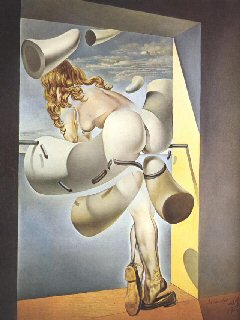Many human activities began as social ones and were shared and with time got transformed into individual and personal ones. This happened especially with the media and technologies. Two examples: transportation, where cars (which are mostly used as a means of personal transportation) imposed themselves on other forms of travel; and the media, where TV, for instance, started being viewed collectively, went on to a TV set for every family, then to one for every single member of the family.
At the root of this there are obvious commercial reasons: the more a product becomes invidividual the more the sales. But this is not the only reason. Commercial needs are coemergent with psychic transformation – the one affects the other. The tendency toward individuality also develops in areas which were “traditionally planned” to be shared.
One of those is sexuality. Masturbation is an evergreen activity, but it hasn’t always been accepted historically. It has been condemned for a long time, mostly through religious rulings, even scaring boys that it would make them blind. Even though masturbation is still not socially accepted in many parts of the world, especially for women, during the so-called sexual revolution of the 1960s and 1970s women established a more direct and aware relationship with their bodies, which included the right to masturbate withour guilt feelings.
But then, as anything which starts as counterculture and a spontaneous social movement, once it becomes somewhat accepted in the mainstream, it then becomes part of the economy, which makes products out of it.
Masturbation is expanding. Among the reasons is the AIDS emergency which produces suspicion compared to the “golden years” of free love; another one is the fast growth of singles and in general of short-term relationships.
Thus a big market is being opened, a market made of objects, porn, sex toys of the more variegate kinds, even remote-controlled and technologically complex sex machines, the Rolls Royce of sex toys. This phenomenon can be creative, fun, and liberating, but at the same time marks an anthropological transformation.
At first glance it seems that sex is becoming technological, but actually it is technology which in the process of digitalization of reality is assimilating human activities more and more. Social life is moving in a digital realm through social networks, the search of a partner and sexual meetings through the dating sites sites, and human biology is seen as a long list of DNA codes.
Becoming part of the big hotchpotch of technology, sex in turn is becoming “personal” and “at click range,” where pleasure, according to what technology offers, has to be immediate, personalized, with various options and, of course, efficient: a guaranteed and quick orgasm. A long wait for orgasm would be as annoying as waiting for a website with a slow Internet connection.
[/en][it]
Molte attività umane sono iniziate come sociali e condivise e nel tempo si sono trasformate in individuali e personali. Questo è avvenuto in particolare per i media e le tecnologie. Due esempi per tutti: il trasporto, dove l’automobile si è imposta sulle altre forme di trasporto ed è perlopiù utlizzata come forma di trasporto personale, e i media, dove ad esempio la televisione, iniziata in forma di visione collettiva, è passata ad una televisione per ogni famiglia e poi ad una per ogni componente del nucleo familiare.
Alla base di questo vi sono ovviamente ragioni commerciali per le quali più un prodotto diviene individuale maggiori sono le vendite, ma non è la sola ragione. Le necessità commerciali sono coemergenti con la trasformazione della psiche, l’una influenza l’altra. La tendenza verso l’individualità si sviluppa anche su aree che erano “tradizionalmente progettati” per la condivisione.
Una di queste è la sessualità. La masturbazione è un’attività sempreverde ma non è sempre stata accettata nella storia. Perlopiù tramite dettami religiosi, è stata condannata per lungo tempo, fino al punto di terrorizzare i ragazzi dicendo loro che sarebbero diventati ciechi. Anche se in molte parti del mondo la masturbazione non è tutt’ora accettata socialmente, in particolare per le donne, durante la cosiddetta rivoluzione sessuale degli anni ’60 e ’70 le donne hanno instaurato una relazione più diretta e consapevole con i loro corpi, includendo in questa il diritto a masturbarsi senza sensi di colpa.
Ma poi, come qualsiasi cosa che inizia come controcultura a partire da un movimento sociale spontaneo, nel momento in cui diventa un minimo accettata, entra come parte dell’economia e vengono creati dei prodotti al riguardo.
Ecco che si apre allora tutto un mercato fatto di oggetti, pornografia, sex toys delle specie più variegate, anche con il controllo remoto via Internet da parte del partner, e sex machines ingegneristicamente complesse, le Rolls Royce dei sex toys. Il fenomeno può risultare creativo, divertente e liberatorio, ma allo stesso tempo segna una trasformazione antropologica.
A prima vista sembra che il sesso stia diventando tecnologico, ma in realtà è la tecnologia che nel suo processo di digitalizzazione della realtà sta assorbendo sempre più attività umane. La vita sociale si sposta in un ambito digitale con i social networks, la ricerca del partner e degli incontri sessuali sui siti appositi, e la biologia umana viene vista come una lunga lista di codici DNA.
Diventando parte del gran calderone della tecnologia, il sesso a sua volta si sta rendendo “personal” e “a portata di clic”, dove il piacere, secondo le offerte della tecnologia, dev’essere immediato, personalizzato, con opzioni variegate e naturalmente, efficiente: l’orgasmo deve essere garantito e veloce. Una lunga attesa per l’orgasmo diventerebbe fastidiosa quanto l’attesa di un sito web con una lenta connessione ad Internet.
[/it]
Leggi tutto “Personal orgasm”






